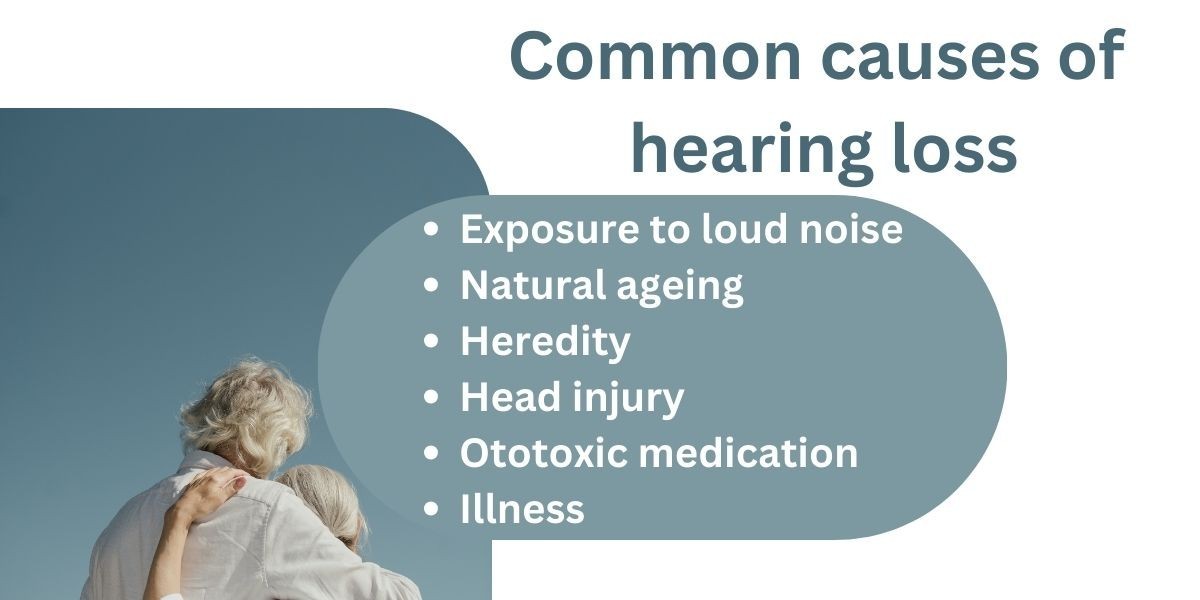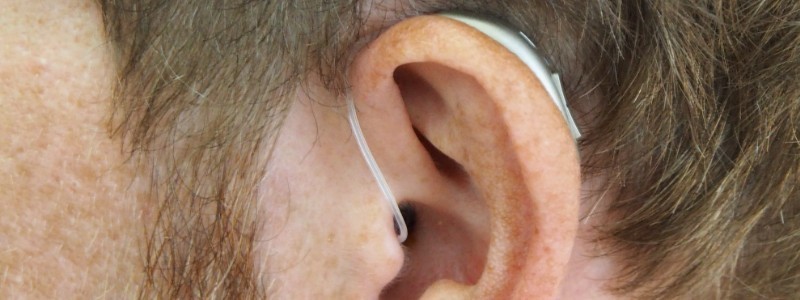
Head of Online Medical Content

Audiology Expert

What is Bilateral Hearing Loss (BHL)?
What is it, what are the symptoms, causes, and treatments?
Introduction | Degrees of hearing loss | Causes | Symptoms | Types | Treatments | Resources | Living with bilateral hearing loss | Conclusion
Last Hearing Aid UK:
Hearing loss in both ears
Bilateral hearing loss refers to the reduction in hearing ability in both ears. It can be caused by factors such as ageing, exposure to loud noises, infections, or genetic conditions. However, it is normally due to the damage of the stereocilia, which are hair-like cells in the inner ear.
Approximately 11 million people in the UK live with some form of hearing loss, with bilateral hearing loss being significantly more common than unilateral (single-ear) hearing loss.
Understanding the condition and seeking early treatment can dramatically improve your quality of life and help prevent further deterioration.
Treatments often require interventions like hearing aids or cochlear implants, depending on severity and type. Here, we briefly discuss the symptoms, causes, treatments, types, and how to live with bilateral hearing loss.
If you've found yourself turning your head frequently to hear someone better or avoiding phone calls because you can’t quite catch what’s being said, you might be dealing with bilateral hearing loss, without even realising it.

A hearing loss in both ears is called bilateral hearing loss
If you have bilateral hearing loss, it means both ears are affected. This type of hearing loss commonly occurs gradually over a long period of time. However, in some instances, it can be sudden, such as the result of too much exposure to loud noises.
How you experience and manage bilateral hearing loss will be different from the next person. For example, the hearing loss can be symmetrical, where the loss is the same severity in both ears or asymmetrical, where the loss is unbalanced. This means you'll hear better on one side.
Imagine trying to have a conversation on a busy train platform or struggling to locate where traffic is coming from when crossing the road; these everyday moments can feel disorienting when hearing in both ears is compromised.
Sound localisation, your ability to determine where sounds are coming from, relies heavily on having balanced hearing in both ears.
When bilateral hearing loss is asymmetrical, this spatial awareness becomes compromised, which can create safety concerns when navigating busy streets or driving.
This is why it is important to be seen by an audiologist if you suspect anything. They will test your hearing, analyse the severity, diagnose the loss, and tailor treatment to your specific needs.
Related reading: Asymmetrical hearing loss
Here are the degrees of hearing loss and what they mean for you:
- Mild: You may hear some speech, but softer sounds or speech from a distance will be difficult to hear.
- Moderate: You might struggle to hear faint speech and will have difficulty with conversations at a normal volume.
- Severe: You’ll likely hear no speech during a conversation at a normal volume and will miss some loud sounds.
- Profound: With profound hearing loss, you won't be able to hear normal or loud speech and will have difficulty with even very loud sounds unless they are extremely loud.
People often dismiss early symptoms, blaming “selective hearing” or just thinking others are mumbling. But recognising these signs early can make a big difference in treatment success.
Research indicates that people with untreated bilateral hearing loss are at increased risk of cognitive decline, with studies showing a link between hearing loss severity and the rate of cognitive deterioration.
Early intervention with hearing aids has been shown to reduce this risk significantly.

Causes of bilateral hearing loss
Genetics: What causes bilateral hearing loss? It is possible to be born with bilateral hearing loss, as it can be inherited from either one or both parents.
Medications: There are some known medications that can be a trigger for developing bilateral hearing loss, such as ototoxic drugs, which can cause damage to the ears.
Common ototoxic medications include certain antibiotics (like gentamicin), chemotherapy drugs (such as cisplatin), high doses of aspirin, and some diuretics. Always discuss potential hearing side effects with your GP if you're prescribed these medications.
Loud noise exposure: If you are exposed to loud noises over a long period of time, it can cause temporary or permanent damage to your hearing.
For example, if you’ve worked on building sites without hearing protection or regularly attended loud gigs without earplugs, your hearing could be taking more damage than you realise.
According to UK health and safety regulations, any workplace noise above 85 decibels requires hearing protection. However, damage can occur at lower levels with prolonged exposure.
Even activities like regular use of power tools, motorcycling, or listening to music through headphones at high volume can contribute to bilateral noise-induced hearing loss over time.
Ageing: Presbycusis, also known as age-related hearing loss, is the most common form of sensorineural hearing loss. This, in turn, is one of two forms of bilateral hearing loss; the other is conductive.
Ear infections and earwax: Continuous ear infections can cause blockages or structural damage to the ears. Similar to earwax buildup, which can also rupture the eardrum if excessive and left untreated.
Even something as simple as regular use of cotton buds can push wax deeper, making symptoms worse—another reason to leave ear care to professionals.
Additional causes include:
- Head trauma or injury affecting both auditory systems
- Autoimmune disorders like Ménière's disease or autoimmune inner ear disease (AIED)
- Viral infections such as measles, mumps, or meningitis
- Cardiovascular conditions that reduce blood flow to the inner ear
- Diabetes which can damage blood vessels and nerves in the auditory system
Symptoms of bilateral hearing loss
What are the symptoms of bilateral hearing loss? It can sometimes be difficult to recognise symptoms of bilateral hearing loss, especially if it is gradual. However, if you do notice any change in your hearing, seek professional advice and support from an audiologist in your area.
Related reading: What is an audiologist?
Here are some common signs:
- Having to rely on lipreading to understand conversations.
- Asking people to repeat what they have said.
- Finding it a challenge to hear within the background noise.
- Having to continuously turn up the volume.
You might also notice you're avoiding busy cafes, withdrawing from conversations at family dinners, or feeling more drained after social interactions due to the effort it takes to listen.
Types of bilateral hearing loss
There are two types of bilateral hearing loss: sensorineural and conductive. In short, sensorineural hearing loss occurs when the tiny hair cells in the inner ear or the auditory nerve, which transmits sound to the brain, are damaged.
This type of hearing loss is typically caused by the natural ageing process or prolonged exposure to loud noises.
Conduction happens in the outer or middle ear, where sound is converted into vibrations and transmitted to the inner ear.
When there's a blockage or other issue in these areas, sound waves may not effectively reach the inner ear. Causes include excessive earwax, a ruptured eardrum, or ear infections.

Bilateral Hearing Loss (BHL)
Treatments and living with this type of hearing loss
Treatments for bilateral hearing loss
Modern hearing aids provide a natural hearing experience for those with bilateral hearing loss. Unlike older models that simply amplify sound, today's hearing aids send detailed sound signals to the brain, allowing for better hearing with less effort.
They significantly improve speech understanding and enhance the clarity and detail of surrounding sounds, creating a clearer listening environment.
With today’s discreet, Bluetooth-enabled hearing aids, you can stream calls, music, and even the telly directly to your ears—ideal for staying connected and avoiding constant volume wars at home.
For more severe cases, if you have experienced profound hearing loss from birth, cochlear implants are an excellent option. These electronic devices are surgically inserted into the inner ear and are a popular solution.
They work by replacing the damaged nerves responsible for sending electrical signals to the brain.
Is bilateral hearing loss a disability?
If you suffer from bilateral hearing loss, you might not consider yourself disabled. However, if your hearing loss is severe or profound, you may be eligible for disability benefits and grants, depending on the extent of the damage.
These resources can assist with daily life, offering support through specialist technologies, assistive devices, and in-person help, enabling you to communicate more effectively, either at home or in the workplace.
Support might include workplace adjustments like amplified telephones, speech-to-text software, or loop systems in public venues like banks and cinemas.
Find out more by visiting the RNID website at www.rnid.org.uk, or download the NHS whitepaper on bilateral hearing loss by clicking on the green button further down the page.
Living with bilateral hearing loss
Living with bilateral hearing loss can be challenging, but today's technology makes it easier. Modern hearing aids and cochlear implants offer clear, detailed sound, enhancing everyday interactions.
Whether you’re catching up with friends over brunch, chatting with grandchildren, or trying to hear station announcements during your morning commute, assistive tech can help bridge those gaps.
Support from loved ones and hearing professionals is also an invaluable part of future hearing health. While adjustments are needed, staying active, social, and engaged helps maintain a fulfilling life despite hearing challenges.
Don’t underestimate the power of community and routine hearing check-ups. Staying proactive can make all the difference in managing your hearing loss confidently and comfortably.
Key takeaways
- Bilateral hearing loss affects both ears – it can be symmetrical (equal loss in both ears) or asymmetrical (worse in one ear than the other)
- Most cases develop gradually due to ageing or noise exposure – but it can also be sudden, genetic, or caused by infections, medications, or earwax buildup
- Common warning signs include: asking people to repeat themselves, relying on lipreading, struggling in noisy places, and constantly turning up the volume
- Two main types exist: sensorineural (damage to inner ear hair cells or auditory nerve) and conductive (blockages in outer or middle ear preventing sound transmission)
- Modern hearing aids transform daily life – today's devices are discreet, Bluetooth-enabled, and provide natural sound by sending detailed signals to your brain rather than just amplifying noise
- Severe bilateral hearing loss may qualify you for disability benefits – including workplace adjustments, assistive technology, and financial support to help you communicate effectively
Conclusion
Bilateral hearing loss is the reduction of hearing in both ears, caused by ageing, loud noise exposure, infections, or genetics. Symptoms include relying on lipreading, asking for repetitions, and difficulty hearing in noisy environments.
There are two types: Sensorineural and conductive. Treatments include modern hearing aids and cochlear implants, which enhance sound clarity and speech understanding. Audiologists provide tailored care, which is essential for managing this condition.
Remember, adapting to bilateral hearing loss is a journey, not a destination. Be patient with yourself as you adjust to hearing aids, learn new communication strategies, and navigate social situations.
With the right support and technology, most people with bilateral hearing loss continue to live full, active, and socially connected lives.
Why Choose Us?
- FREE Hearing Tests
- Best Hearing Aids and Prices
- FREE Aftercare for Life
- FREE Home Visits
- 200+ Local Audiologists
- 60 Day Money Back Guarantee
Think you might have bilateral hearing loss?
If you're experiencing hearing difficulties in both ears, you don't have to face it alone.
Our expert audiologists are here to help you understand your hearing loss and find the perfect solution for your lifestyle.
Book your free hearing assessment today – available in our clinic or in the comfort of your own home. No obligation, just clear answers and compassionate support.
Other hearing loss awareness articles you might like...
 Accepting Hearing Loss
Accepting Hearing Loss  Tips for hearing in restaurants
Tips for hearing in restaurants  The impact of hearing loss and relationships
The impact of hearing loss and relationships Our specialist service includes:
Do not spend hundreds of pounds without getting a second opinion from us.
Please call us on 0800 567 7621
 Not only are the prices great, but the service is fantastic! Many thanks to your team.
Not only are the prices great, but the service is fantastic! Many thanks to your team.What's included in our hearing aid prices?
FAQs
In general, any audiologist will always recommend to you the hearing aid model that best suits your needs. Here is a useful checklist to make sure that is the case.
- Audiologist's level of knowledge: The audiologist you have seen will hopefully have a wide knowledge of all available hearing aids; however, some will only be familiar with a small number of brands and, therefore, may not really be in a position to know which model is the best for you. It is OK to challenge their recommendation and ask them to justify why this particular brand is the one for you.
- Do research: Read about the hearing aid that was recommended. Does it seem like it will suit your lifestyle? Does it have more or fewer features than you need?
- Be aware of sales targets: Many high street retailers have specific tie-ins to a particular manufacturer/brand. The hearing aid they have suggested may still be the correct one for you, but do your research so that you know why they might have recommended it.
If you have significant hearing loss in both ears, you should be wearing two hearing aids. Here are the audiological reasons why:
Localisation: The brain decodes information from both ears and compares and contrasts them. By analysing the minuscule time delays as well as the difference in the loudness of each sound reaching the ears, the person is able to accurately locate a sound source.
Simply put, if you have better hearing on one side than the other, you can't accurately tell what direction sounds are coming from.
Less amplification is required: A phenomenon known as “binaural summation” means that the hearing aids can be set at a lower and more natural volume setting than if you wore only one hearing aid.
Head shadow effect: High frequencies, the part of your hearing that gives clarity and meaning to speech sounds, cannot bend around your head. Only low frequencies can. Therefore, if someone is talking on your unaided side, you are likely to hear that they are speaking, but be unable to tell what they have said.
Noise reduction: The brain has its own built-in noise reduction, which is only really effective when it is receiving information from both ears. If only one ear is aided, even with the best hearing aid in the world, it will be difficult for you to hear in background noise as your brain is trying to retain all of the sounds (including background noise) rather than filtering them out.
Sound quality: We are designed to hear in stereo. Only hearing from one side sounds a lot less natural to us.
Fancy some further reading on this topic? You can read about why two hearing aids are better than one in our article, hearing aids for Both Ears, here
For most people, the main benefit of a rechargeable hearing aid is simple convenience. We are used to plugging in our phones and other devices overnight for them to charge up. Here are some other pros and cons:
For anybody with poor dexterity or issues with their fingers, having a rechargeable aid makes a huge difference, as normal hearing aid batteries are quite small and some people find them fiddly to change.
One downside is that if you forget to charge your hearing aid, then it is a problem that can't be instantly fixed. For most, a 30-minute charge will get you at least two or three hours of hearing, but if you are the type of person who is likely to forget to plug them in regularly, then you're probably better off with standard batteries.
Rechargeable aids are also a little bit bigger and are only available in Behind-the-Ear models.
Finally, just like with a mobile phone, the amount of charge you get on day one is not going to be the same as you get a few years down the line. Be sure to ask what the policy is with the manufacturer's warranty when it comes to replacing the battery.
For most people, the answer is yes. But it's never that simple.
The majority of hearing problems affect the high frequencies a lot more than the low ones. Therefore, open fitting hearing aids sound a lot more natural and ones that block your ears up can make your own voice sound like you are talking with your head in a bucket. Therefore, in-ear aids tend to be less natural.
However, the true answer is we can't tell until we have had a look in your ears to assess the size of your ear canal, and until we have tested your hearing to see which frequencies are being affected.
People with wider ear canals tend to have more flexibility, also there are open fitting modular CIC hearing aids now that do not block your ears.
There is also the age-old rule to consider, that a hearing aid will not help you if it's sat in the drawer gathering dust. If the only hearing aid you would be happy wearing is one that people can't see, then that's what you should get.
Most people can adapt to any type of hearing aid, as long as they know what to expect. Have an honest conversation with your audiologist as to what your needs are.
Generally speaking, six or more. Unless it's none at all. The number of channels a hearing aid has is often a simplistic way an audiologist will use to explain why one hearing aid is better than another, but channels are complex, and it is really not that straightforward. Here are some reasons why:
Hearing aids amplify sounds of different frequencies by different amounts. Most people have lost more high frequencies than low, and therefore need more amplification in the high frequencies. The range of sounds you hear is split into frequency bands or channels, and the hearing aids are set to provide the right amount of hearing at each frequency level.
Less than six channels, and this cannot be done with much accuracy, so six is the magic number. However, a six-channel aid is typically very basic with few other features and is suitable only for hearing a single speaker in a quiet room. The number of channels is not what you should be looking at; it's more the rest of the technology that comes with them.
As a final note, different manufacturers have different approaches. One method is not necessarily better than any other. For example, some manufacturers have as many as 64 channels in their top aids. Most tend to have between 17 and 20. One manufacturer has no channels at all.
Manufacturer's warranties typically last between 2-5 years, depending on the brand and model, and cover defects in materials and workmanship. This includes repairs for component failures, electronic malfunctions, and manufacturing defects, but excludes damage from misuse, accidents, or normal wear. Most manufacturers also include loss and damage insurance for the first year.
We handle all warranty claims on your behalf, liaising with manufacturers and ensuring you get replacement devices quickly when needed. This comprehensive warranty coverage, combined with our lifetime aftercare, gives you complete peace of mind.
Our hearing tests are completely free, whether at our clinics or in your home. Unlike other providers who charge £30-£100 for home visits, we believe hearing healthcare should be accessible without financial barriers. Our comprehensive assessments include examination by a registered audiologist, audiogram results, and personalised recommendations.
All testing, future adjustments, and ongoing support are included at no extra cost. While NHS tests are also free, typical 6-week waiting periods often lead people to seek immediate private testing. We provide prompt, professional assessments that fit your schedule and budget.
Yes, we offer completely free home visits throughout the UK, and this service is included in our prices with no additional charges. Home visits are particularly valuable for people with mobility issues, busy schedules, or those who simply prefer the comfort and convenience of their own environment.
Our audiologists can conduct full hearing tests, fit hearing aids, and provide ongoing support in your home. This service sets us apart from many providers who either don't offer home visits or charge extra for them.
We can offer prices up to 40% lower than high street retailers because of our business model. As a network of 200+ independent audiologists, we don't have the massive overheads of large retail chains - no expensive high street premises, no sales targets pushing audiologists to sell the most expensive options, and no costly marketing campaigns.
However, we maintain the same buying power as the big chains because we purchase on behalf of our entire nationwide network. This means you get access to the same premium hearing aids with professional service, but at genuinely competitive prices.
We offer a comprehensive 60-day money-back guarantee, which gives you twice the industry standard time to properly assess whether your hearing aids are right for you. This extended period recognises that adjusting to hearing aids takes time, and your brain needs several weeks to adapt to the amplified sounds.
Unlike many providers who offer just 30 days, we believe 60 days gives you the confidence to test your hearing aids in all the situations that matter to you - from quiet conversations at home to busy restaurants and outdoor activities.
Other pages you might find useful
Ask the Experts
6 Morton Lane
Walkwood
Redditch
Worcestershire
B97 5QA
Latest Launch
When we refer to a product as 'Latest Launch', we mean it is the latest to be released on the market.
New
When we refer to a product as 'New', we mean that the product is the newest hearing aid model on the market.
When we refer to a product as 'Superseded', we mean that there is a newer range available which replaces and improves on this product.
Older Model
When we refer to a product as an 'Older Model', we mean that it is has been superseded by at least two more recent hearing aid ranges.
